Geology and U-Th-Pb Dating of the Gakara REE Deposit, Burundi
Abstract
:1. Introduction
2. Geology
2.1. Pan-African in East Africa
2.2. Alkaline Magmatism in the Region
2.3. Geology of the Gakara Area
3. Field Data
3.1. Host Rocks
3.2. Types of Mineralization
4. Petrology and Mineralogy
4.1. Ore Sample Description and Typology
4.2. Mineralogical Assemblages
5. Geochronology
5.1. Materials and Methods
5.2. Results
5.2.1. Monazite Dating
5.2.2. Bastnaesite Dating
6. Discussion
6.1. Sequence of Events
6.2. Structural Controls and Associated Fluid Pressure
6.3. Geodynamic Context of the Gakara REE Ore Deposition
7. Conclusions
Author Contributions
Funding
Acknowledgments
Conflicts of Interest
Appendix A
| Laboratory & Sample Preparation | |
|---|---|
| Laboratory name | Géosciences Rennes, UMR CNRS 6118, Rennes, France |
| Sample type/mineral | Monazite and Bastnaesite |
| Sample preparation | Polished thin sections |
| Imaging | Back-scattered electron imaging (CMEBA, University Rennes 1) |
| Laser ablation system | |
| Make, Model & type | ESI NWR193UC, Excimer |
| Ablation cell | ESI NWR TwoVol2 |
| Laser wavelength | 193 nm |
| Pulse width | <5 ns |
| Fluence | 7.7 J/cm2 |
| Repetition rate | 2 Hz (Mnz (1)) and 10 Hz (Cal (2)) |
| Spot size | 20 μm (Mnz (1)) and 100 μm (Cal (2)) |
| Sampling mode/pattern | Single spot |
| Carrier gas | 100% He, Ar make-up gas and N2 (3 mL/mn) combined using in-house smoothing device |
| Background collection | 20 s |
| Ablation duration | 60 s (Mnz (1)) and 40 s (Cal (2)) |
| Wash-out delay | 15 s |
| Cell carrier gas flow (He) | 0.75 L/min |
| ICP-MS Instrument | |
| Make, Model & type | Agilent 7700x, Q-ICP-MS |
| Sample introduction | Via conventional tubing |
| RF power | 1350 W |
| Sampler, skimmer cones | Ni |
| Extraction lenses | X type |
| Make-up gas flow (Ar) | 0.87 L/min |
| Detection system | Single collector secondary electron multiplier |
| Data acquisition protocol | Time-resolved analysis |
| Scanning mode | Peak hopping, one point per peak |
| Detector mode | Pulse counting, dead time correction applied, and analog mode when signal intensity > ~106 cps |
| Masses measured | 43Ca (only for Cal (2)), 204(Hg + Pb), 206Pb, 207Pb, 208Pb, 232Th, 238U |
| Integration time per peak | 10–30 ms |
| Sensitivity/Efficiency | 27,000 cps/ppm Pb (50 µm, 10 Hz) |
| Data Processing | |
| Gas blank | 20 s on-peak |
| Calibration strategy | Moacir monazite and calcite WC-1 used as primary reference materials, Manangoutry monazite and calcite WC-1 used as secondary reference materials (quality control) |
| Reference Material info | Moacir Monazite ([35,46]) Calcite WC-1 [40] Manangoutry monazite [33] |
| Data processing package used | Glitter [32] for Mnz (1) and Iolite [47] with VizualAge_UcomPbine [38] for Cal (2) |
| Uncertainty level & propagation | Propagation is by quadratic addition according to [48]. Reproducibility and age uncertainty of reference material are propagated. |
| Quality control/Validation | Manangoutry: 557.7 ± 3.1 Ma (N = 10, MSWD = 0.40) WC-1: Wtd ave 207Pb corrected age: 257.7 ± 4.8 Ma (N = 5, MSWD = 2.2) |
References
- Chakhmouradian, A.R.; Zaitsev, A.N. Rare Earth Mineralization in Igneous Rocks: Sources and Processes. Elements 2012, 8, 347–353. [Google Scholar] [CrossRef]
- Rasoamalala, V.; Salvi, S.; Béziat, D.; Ursule, J.-P.; Cuney, M.; de Parseval, P.; Guillaume, D.; Moine, B.; Andriamampihantona, J. Geology of bastnaesite and monazite deposits in the Ambatofinandrahana area, central part of Madagascar: An overview. J. Afr. Earth Sci. 2014, 94, 128–140. [Google Scholar] [CrossRef]
- Lehmann, B.; Nakai, S.; Höhndorf, A.; Brinckmann, J.; Dulski, P.; Hein, U.F.; Masuda, A. REE mineralization at Gakara, Burundi: Evidence for anomalous upper mantle in the western Rift Valley. Geochim. Cosmochim. Acta 1994, 58, 985–992. [Google Scholar] [CrossRef]
- Hein, U. The bastnaesite-monazite deposits of Gakara/Burundi: Composition of fluid inclusions and genetic implications. Freiberg. Forsch. 1998, C 475, 95–105. [Google Scholar]
- Song, W.; Xu, C.; Smith, M.P.; Chakhmouradian, A.R.; Brenna, M.; Kynický, J.; Chen, W.; Yang, Y.; Deng, M.; Tang, H. Genesis of the world’s largest rare earth element deposit, Bayan Obo, China: Protracted mineralization evolution over ∼1 b.y. Geology 2018, 46, 323–326. [Google Scholar] [CrossRef]
- Nakai, S.; Masuda, A.; Lehmann, B. La-Ba dating of bastnaesite. Am. Mineral. 1988, 73, 1111–1113. [Google Scholar] [CrossRef]
- Kröner, A.; Stern, R.J. Pan-African Orogeny. Encycl. Geol. 2005, 1, 1–12. [Google Scholar]
- Bumby, A.J.; Guiraud, R. The geodynamic setting of the Phanerozoic basins of Africa. J. Afr. Earth Sci. 2005, 43, 1–12. [Google Scholar] [CrossRef]
- Stern, R.J. Arc Assembly and Continental collision in the Neoproterozoic East African orogen: Implications for the consolidation of Gondwanaland. Annu. Rev. Earth Planet. Sci. 1994, 22, 319–351. [Google Scholar] [CrossRef]
- Midende, G.; Boulvais, P.; Tack, L.; Melcher, F.; Gerdes, A.; Dewaele, S.; Demaiffe, D.; Decrée, S. Petrography, geochemistry and U–Pb zircon age of the Matongo carbonatite Massif (Burundi): Implication for the Neoproterozoic geodynamic evolution of Central Africa. J. Afr. Earth Sci. 2014, 100, 656–674. [Google Scholar] [CrossRef] [Green Version]
- Chorowicz, J. The East African rift system. J. Afr. Earth Sci. 2005, 43, 379–410. [Google Scholar] [CrossRef]
- Koptev, A.; Burov, E.; Calais, E.; Leroy, S.; Gerya, T.; Guillou-Frottier, L.; Cloetingh, S. Contrasted continental rifting via plume-craton interaction: Applications to Central East African Rift. Geosci. Front. 2016, 7, 221–236. [Google Scholar] [CrossRef] [Green Version]
- Tack, L.; De Paepe, P.; Deutsch, S.; Liégeois, J.P. The alkaline plutonic complexof the Upper Ruvubu (Burundi): Geology, age, isotopic geochemistry and implications for the regional geology of the Western rift. In African Geology; Klerkx, J., Michot, J., Eds.; Musée Royal Afrique Centrale: Tervuren, Belgium, 1984; pp. 91–114. [Google Scholar]
- Kampunzu, A.B.; Lubala, R.T.; Makutu, M.N.; Caron, J.-P.H.; Rocci, G.; Vellutini, P.-J. Les complexes alcalins de la région interlacustre à l’est du Zaïre et au Burundi: Un exemple de massifs anorogéniques de relaxation. J. Afr. Earth Sci. 1985, 3, 151–167. [Google Scholar] [CrossRef]
- Tack, L.; De Paepe, P.; Liégeois, J.P.; Nimpagaritse, G.; Ntungicimpaye, A.; Midende, G. Late Kibaran magmatism in Burundi. J. Afr. Earth Sci. Middle East 1990, 10, 733–738. [Google Scholar] [CrossRef]
- Decrée, S.; Boulvais, P.; Cobert, C.; Baele, J.-M.; Midende, G.; Gardien, V.; Tack, L.; Nimpagaritse, G.; Demaiffe, D. Structurally-controlled hydrothermal alteration in the syntectonic Neoproterozoic Upper Ruvubu Alkaline Plutonic Complex (Burundi): Implications for REE and HFSE mobilities. Precambrian Res. 2015, 269, 281–295. [Google Scholar] [CrossRef] [Green Version]
- Van Wambeke, L. The Karonge rare earth deposits, Republic of Burundi: New mineralogical-geochemical data and origin of the mineralization. Miner. Deposita 1977, 12, 373–380. [Google Scholar] [CrossRef]
- Wyllie, P.J. Origin of Carbonatites: Evidence from Phase Equilibrium Studies. In Carbonatites: Genesis and Evolution; Bell, K., Ed.; Unwin Hyman: London, UK, 1989; pp. 500–545. ISBN 978-0-04-445068-9. [Google Scholar]
- Ngwenya, B.T. Hydrothermal rare earth mineralisation in carbonatites of the Tundulu complex, Malawi: Processes at the fluid/rock interface. Geochim. Cosmochim. Acta 1994, 58, 2061–2072. [Google Scholar] [CrossRef]
- Wyllie, P.J.; Jones, A.P.; Deng, J. Rare earth elements in carbonate-rich melts from mantle to crust. In Unspecified; Chapman and Hall: London, UK, 1995; Volume 7, pp. 77–104. [Google Scholar]
- Williams-Jones, A.E.; Wood, S.A. A preliminary petrogenetic grid for REE fluorocarbonates and associated minerals. Geochim. Cosmochim. Acta 1992, 56, 725–738. [Google Scholar] [CrossRef]
- Tack, L.; Wingate, M.T.D.; De Waele, B.; Meert, J.; Belousova, E.; Griffin, B.; Tahon, A.; Fernandez-Alonso, M. The 1375 Ma “Kibaran event” in Central Africa: Prominent emplacement of bimodal magmatism under extensional regime. Precambrian Res. 2010, 180, 63–84. [Google Scholar] [CrossRef]
- Fernandez-Alonso, M.; Cutten, H.; De Waele, B.; Tack, L.; Tahon, A.; Baudet, D.; Barritt, S.D. The Mesoproterozoic Karagwe-Ankole Belt (formerly the NE Kibara Belt): The result of prolonged extensional intracratonic basin development punctuated by two short-lived far-field compressional events. Precambrian Res. 2012, 216, 63–86. [Google Scholar] [CrossRef]
- Theunissen 1986: Carte Géologique du Burundi, Feuille Rumonge; Echelle: 1/100000, S4/29-SW; Musée Royal Afrique Centrale: Tervuren, Belgium, 1986.
- Theunissen 1989: Carte Géologique du Burundi, Feuille Bujumbura; Echelle: 1/100000, S4/29-NW; Musée Royal Afrique Centrale: Tervuren, Belgium, 1989.
- Claessens and Theunissen 1988: Carte géologique du Burundi, Feuille Bururi et Gitega; S4/29-NE, Echelle: 1/100000; Musée Royal Afrique Centrale: Tervuren, Belgium, 1988.
- Kretz, R. Symbols for rock-forming minerals. Am. Mineral. 1983, 68, 277–279. [Google Scholar]
- Whitney, D.L.; Evans, B.W. Abbreviations for names of rock-forming minerals. Am. Mineral. 2010, 95, 185–187. [Google Scholar]
- Aderca, B.-M.; van Tassel, R. Le Gisement de Terres Rares de la Karonge (République du Burundi); Académie Royale des Sciences D’outre-mer: Bruxelles, Belgium, 1971. [Google Scholar]
- Ballouard, C.; Boulvais, P.; Poujol, M.; Gapais, D.; Yamato, P.; Tartèse, R.; Cuney, M. Tectonic record, magmatic history and hydrothermal alteration in the Hercynian Guérande leucogranite, Armorican Massif, France. Lithos 2015, 220, 1–22. [Google Scholar] [CrossRef]
- Gasquet, D.; Bertrand, J.-M.; Paquette, J.-L.; Lehmann, J.; Ratzov, G.; De Ascencao Guedes, R.; Tiepolo, M.; Boullier, A.-M.; Scaillet, S.; Nomade, S. Miocene to Messinian deformation and hydrothermal activity in a pre-alpine basement massif of the French Western Alps: New U-Th-Pb and Argon ages from the Lauzière massif. Bull. Société Géol. Fr. 2010, 181, 227–241. [Google Scholar] [CrossRef]
- Van Achterbergh, E.; Ryan, C.; Jackson, S.; Griffin, W. Data reduction software for LA–ICP–MS: Appendix. In Laser Ablation-ICP-Mass Spectrometry in the Earth Sciences; Principles and Applications; Mineralogical Association of Canada: Québec, QC, Canada, 2001; pp. 239–243. [Google Scholar]
- Paquette, J.L.; Tiepolo, M. High resolution (5 μm) U–Th–Pb isotope dating of monazite with excimer laser ablation (ELA)-ICPMS. Chem. Geol. 2007, 240, 222–237. [Google Scholar] [CrossRef]
- Sal’nikova, E.B.; Yakovleva, S.Z.; Nikiforov, A.V.; Kotov, A.B.; Yarmolyuk, V.V.; Anisimova, I.V.; Sugorakova, A.M.; Plotkina, Y.V. Bastnaesite: A promising U-Pb geochronological tool. Dokl. Akad. Nauk 2010, 430, 386–388. [Google Scholar] [CrossRef]
- Yang, Y.-H.; Wu, F.-Y.; Li, Y.; Yang, J.-H.; Xie, L.-W.; Liu, Y.; Zhang, Y.-B.; Huang, C. In situ U–Pb dating of bastnaesite by LA-ICP-MS. J. Anal. At. Spectrom. 2014, 29, 1017–1023. [Google Scholar] [CrossRef]
- Ling, X.X.; Li, Q.L.; Liu, Y.; Yang, Y.H.; Liu, Y.; Tang, G.Q.; Li, X.H. In situ SIMS Th–Pb dating of bastnaesite: Constraint on the mineralization time of the Himalayan Mianning–Dechang rare earth element deposits. J. Anal. At. Spectrom. 2016, 31, 1680–1687. [Google Scholar] [CrossRef]
- Sylvester, P.J. LA-(MC)-ICP-MS trends in 2006 and 2007 with particular emphasis on measurement uncertainties. Geostand. Geoanal. 2008, 32, 469–488. [Google Scholar] [CrossRef]
- Roberts, W.N.M.; Rasbury, E.T.; Parrish, R.R.; Smith, C.J.; Horstwood, M.S.A.; Condon, D.J. A calcite reference material for LA-ICP-MS U-Pb geochronology. Geochem. Geophys. Geosyst. 2017, 18, 2807–2814. [Google Scholar] [CrossRef] [Green Version]
- Chew, D.M.; Petrus, J.A.; Kamber, B.S. U–Pb LA–ICPMS dating using accessory mineral standards with variable common Pb. Chem. Geol. 2014, 363, 185–199. [Google Scholar] [CrossRef] [Green Version]
- Pochon, A.; Poujol, M.; Gloaguen, E.; Branquet, Y.; Cagnard, F.; Gumiaux, C.; Gapais, D. U-Pb LA-ICP-MS dating of apatite in mafic rocks: Evidence for a major magmatic event at the Devonian-Carboniferous boundary in the Armorican Massif (France). Am. Mineral. 2016, 101, 2430–2442. [Google Scholar] [CrossRef]
- Ludwig, K. User’s Manual for Isoplot 3.75. A Geochronological Toolkit for Microsoft Excel; Berkeley Geochronological Center: Berkeley, CA, USA, 2012; pp. 1–75. [Google Scholar]
- Ludwig, K.R. On the Treatment of Concordant Uranium-Lead Ages. Geochim. Cosmochim. Acta 1998, 62, 665–676. [Google Scholar] [CrossRef]
- Poujol, M.; Pitra, P.; Driessche, J.V.D.; Tartèse, R.; Ruffet, G.; Paquette, J.-L.; Poilvet, J.-C. Two-stage partial melting during the Variscan extensional tectonics (Montagne Noire, France). Int. J. Earth Sci. 2017, 106, 477–500. [Google Scholar] [CrossRef] [Green Version]
- Thoreau, J.; Aderca, B.-M.; Van Wambeke, L. Le gisement de terres rares de la Karonge (Burundi). Acad. R. Sci. Outre-Mer. 1958, 4, 684–715. [Google Scholar]
- Unrug, R. The assembly of Gondwanaland. Scientific results of IGCP Project 288: Gondwanaland sutures and mobile belts. Episodes 1996, 19, 11–20. [Google Scholar]
- Fletcher, I.R.; McNaughton, N.J.; Davis, W.J.; Rasmussen, B. Matrix effects and calibration limitations in ion probe U–Pb and Th–Pb dating of monazite. Chem. Geol. 2010, 270, 31–44. [Google Scholar] [CrossRef]
- Paton, C.; Woodhead, J.D.; Hellstrom, J.C.; Hergt, J.M.; Greig, A.; Maas, R. Improved laser ablation U-Pb zircon geochronology through robust downhole fractionation correction. Geochem. Geophys. Geosyst. 2010, 11, 36. [Google Scholar] [CrossRef]
- Horstwood, M.S.A.; Foster, G.L.; Parrish, R.R.; Noble, S.R.; Nowell, G.M. Common-Pb corrected in situ U-Pb accessory mineral geochronology by LA-MC-ICP-MS. J. Anal. Spectrom. 2003, 18, 837–846. [Google Scholar] [CrossRef]
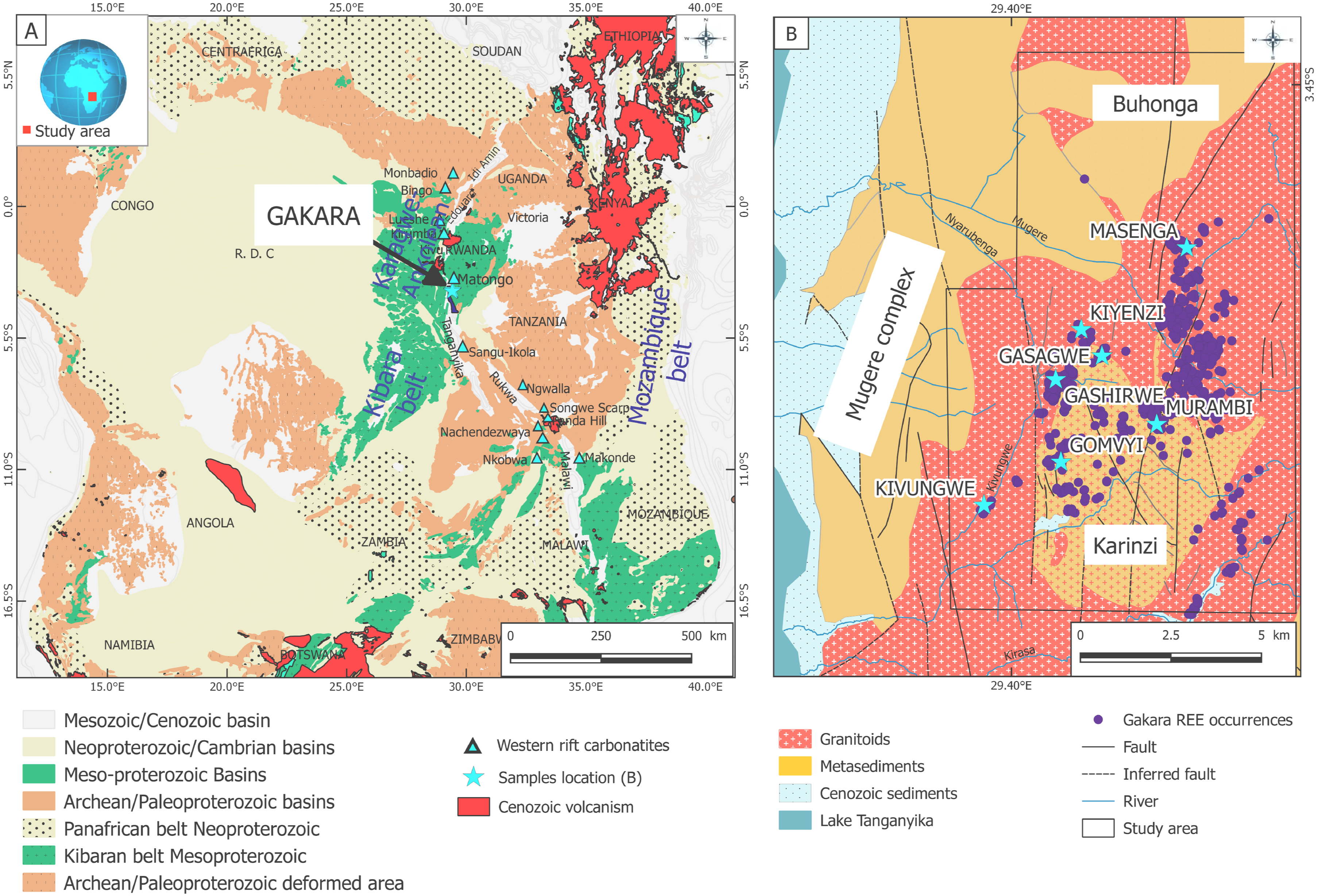
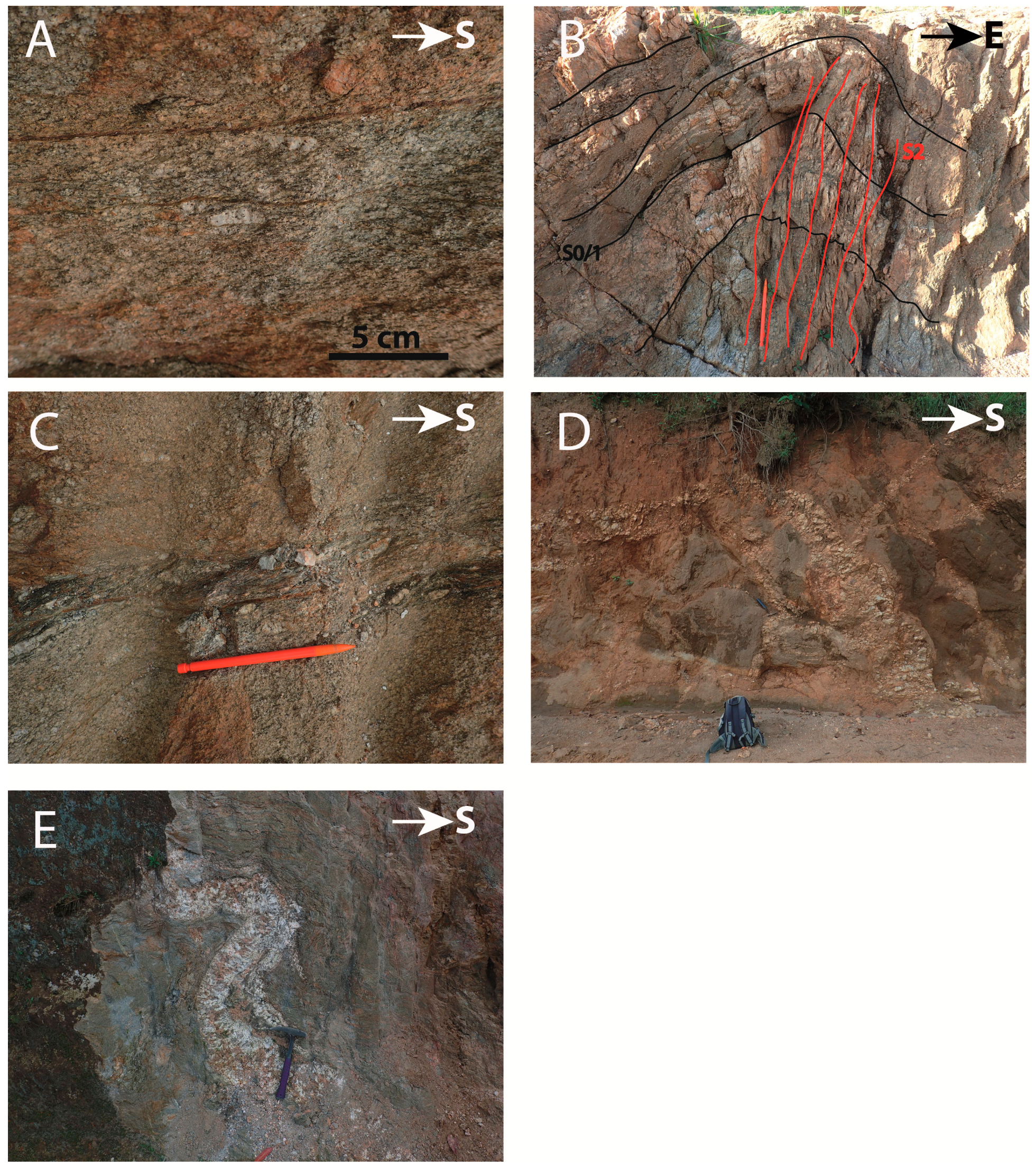


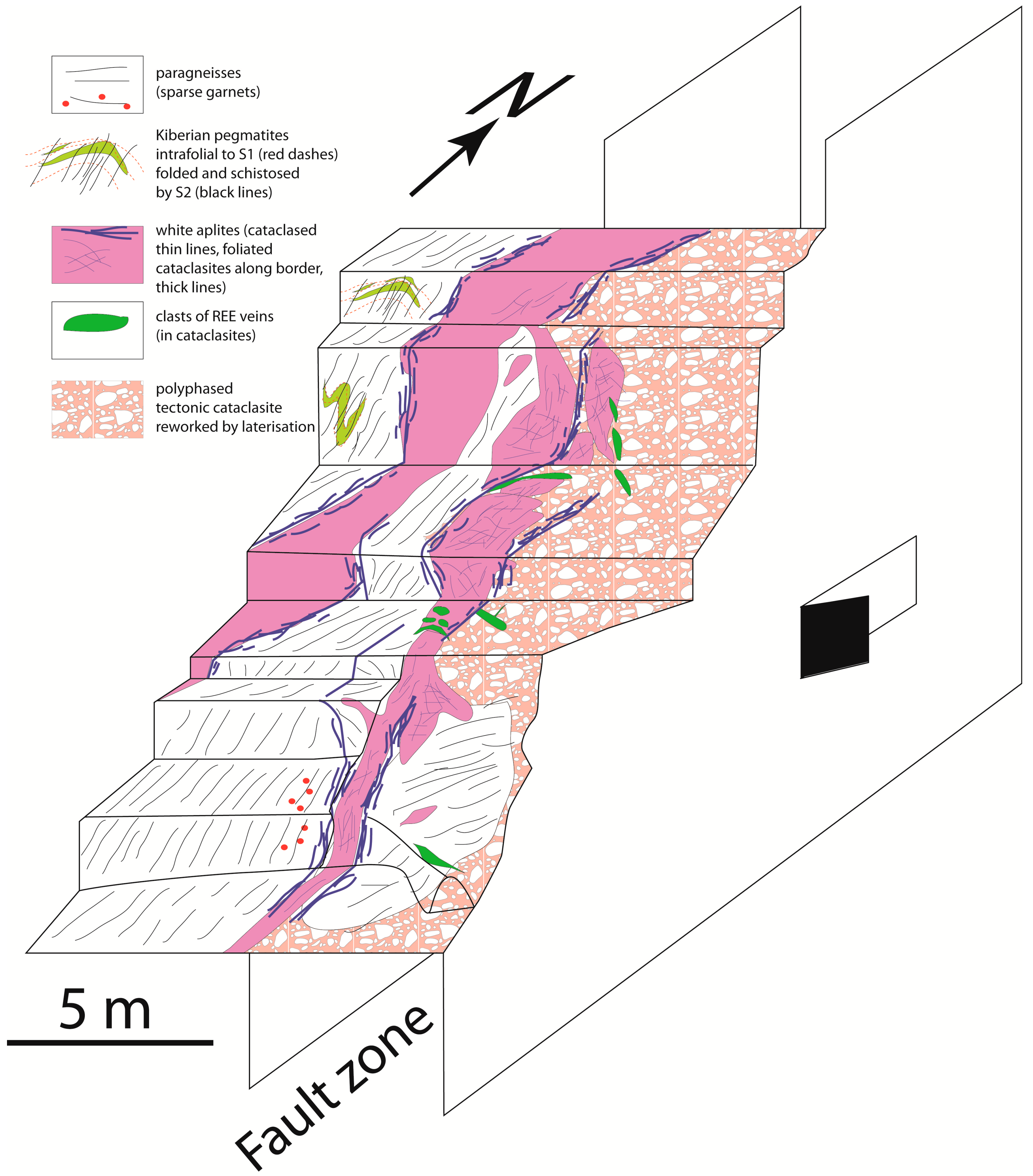
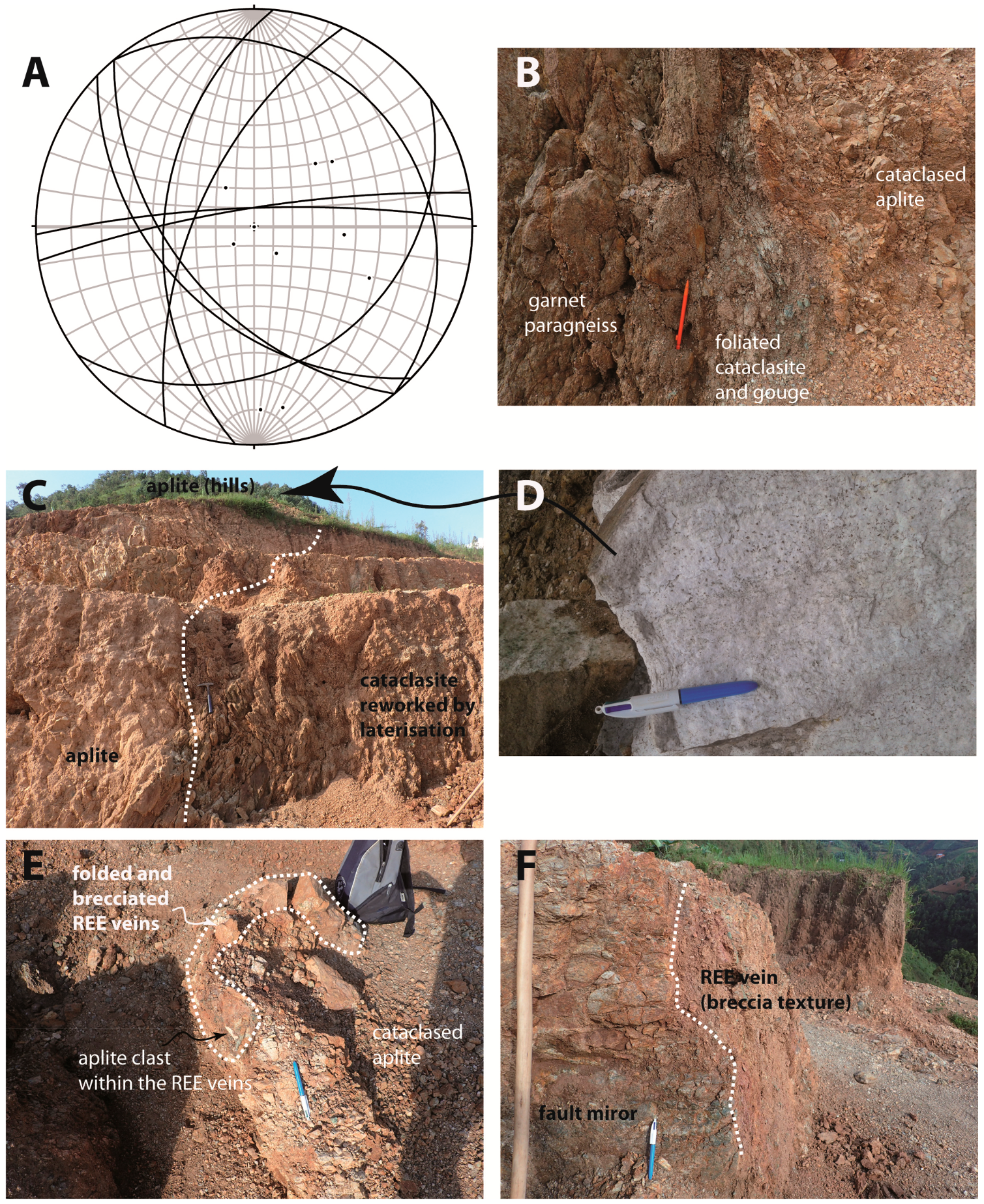
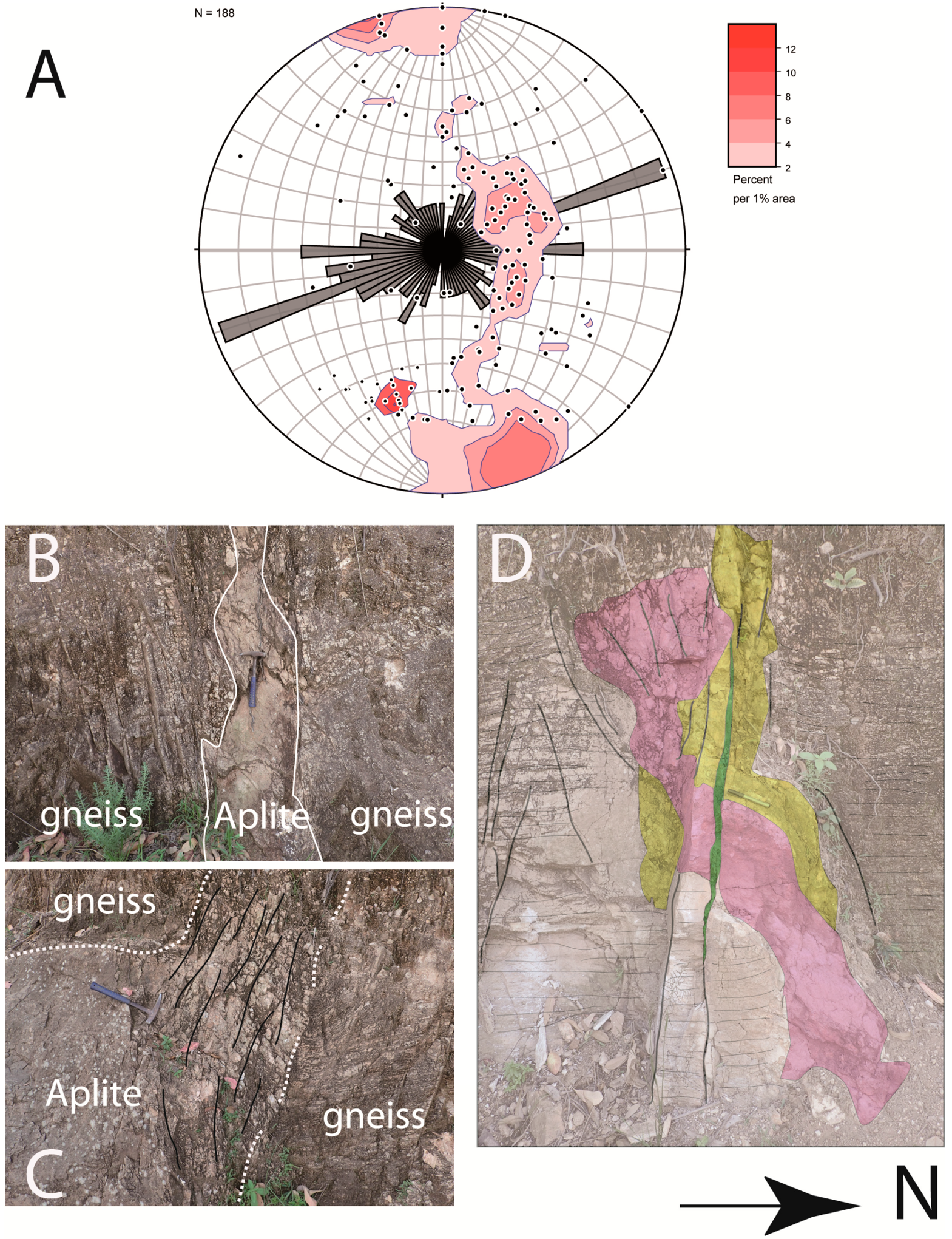
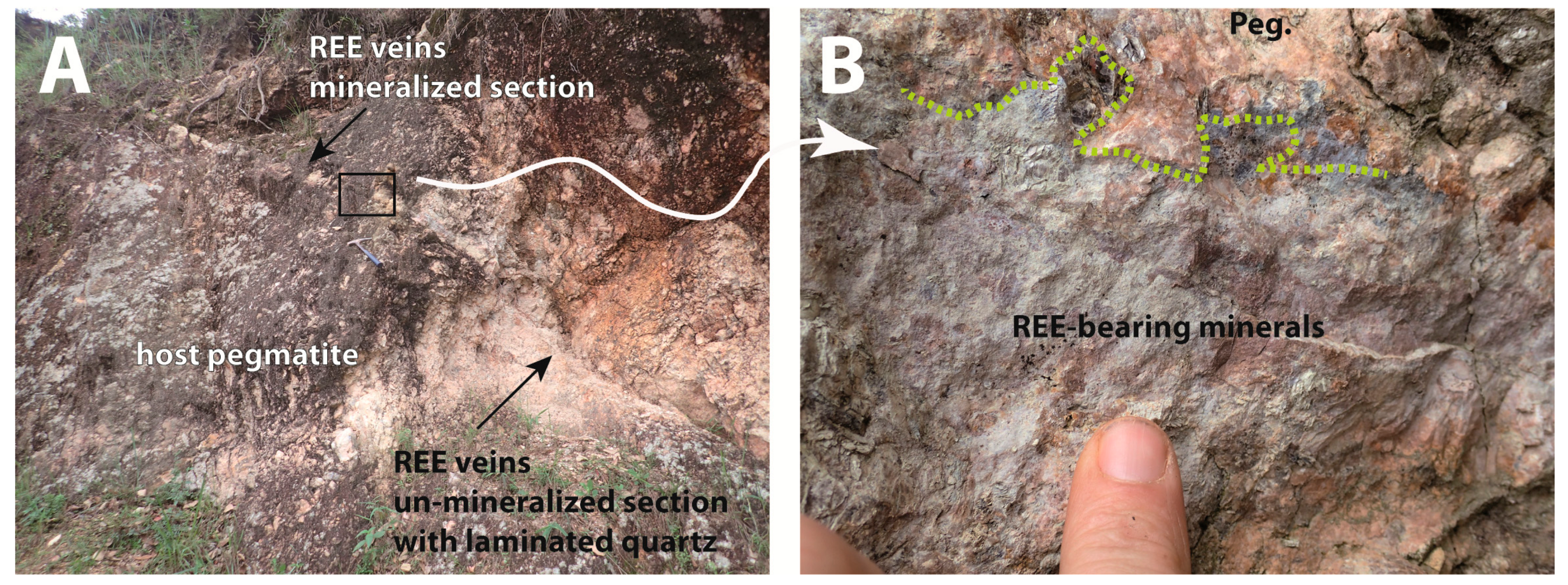

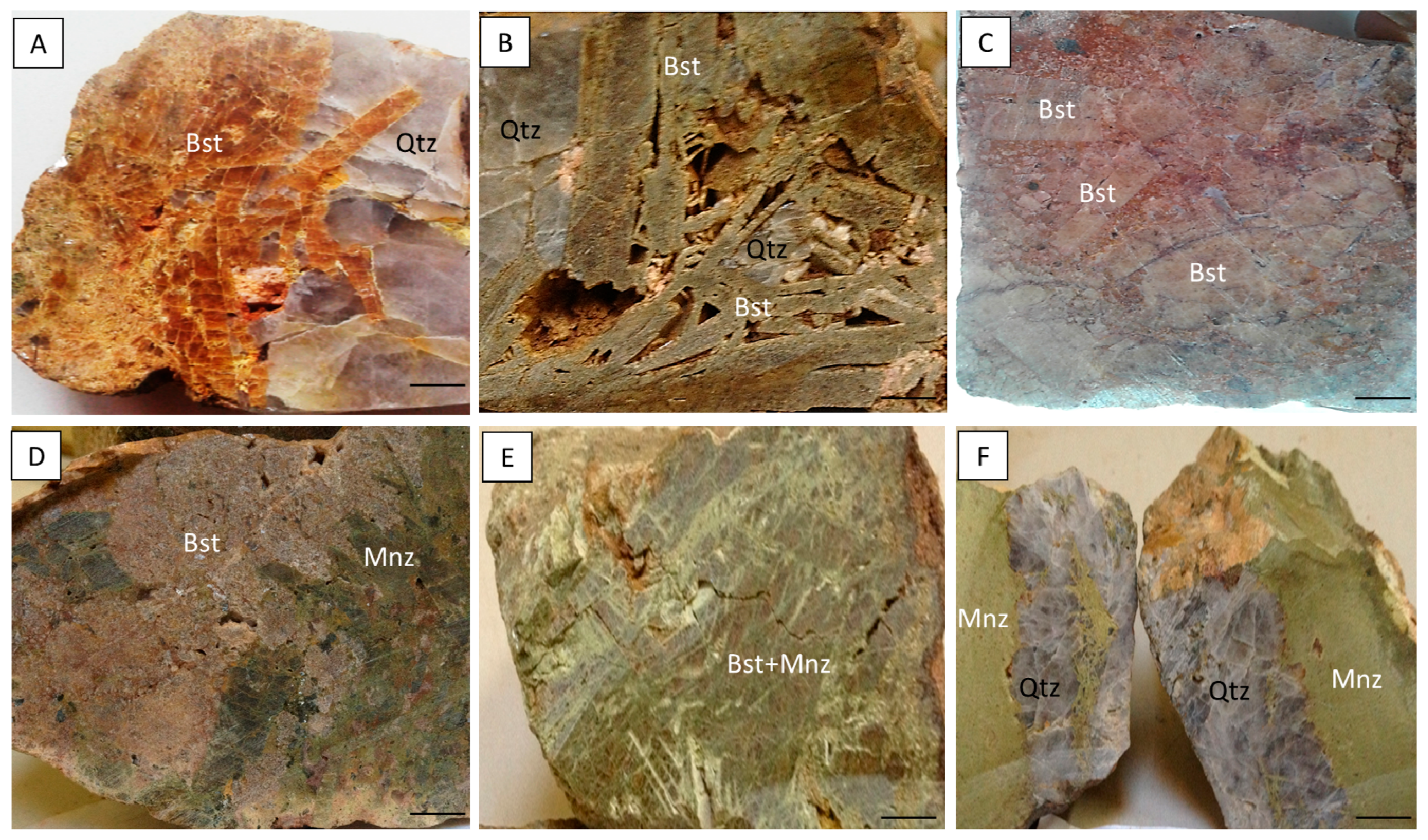
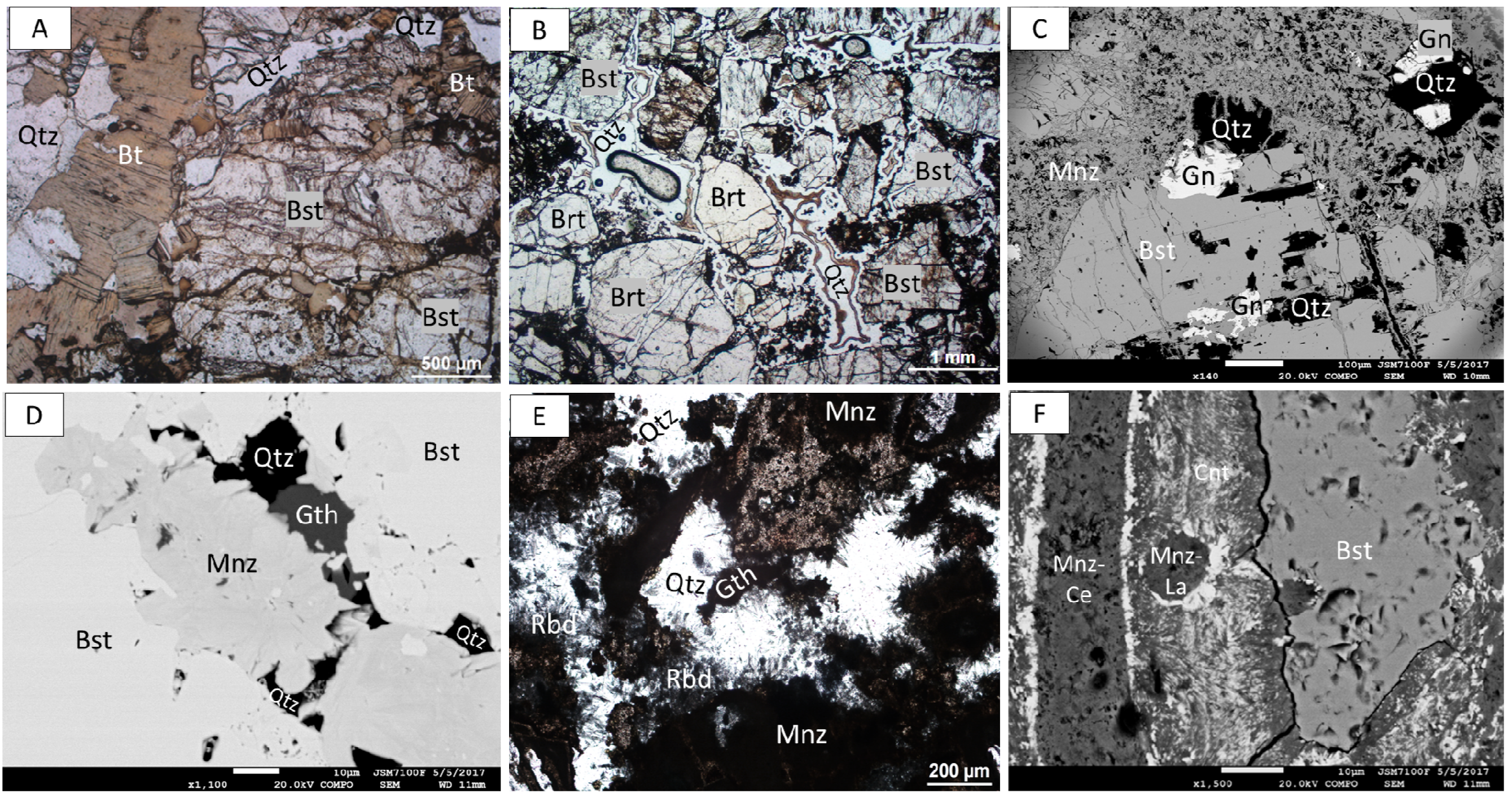

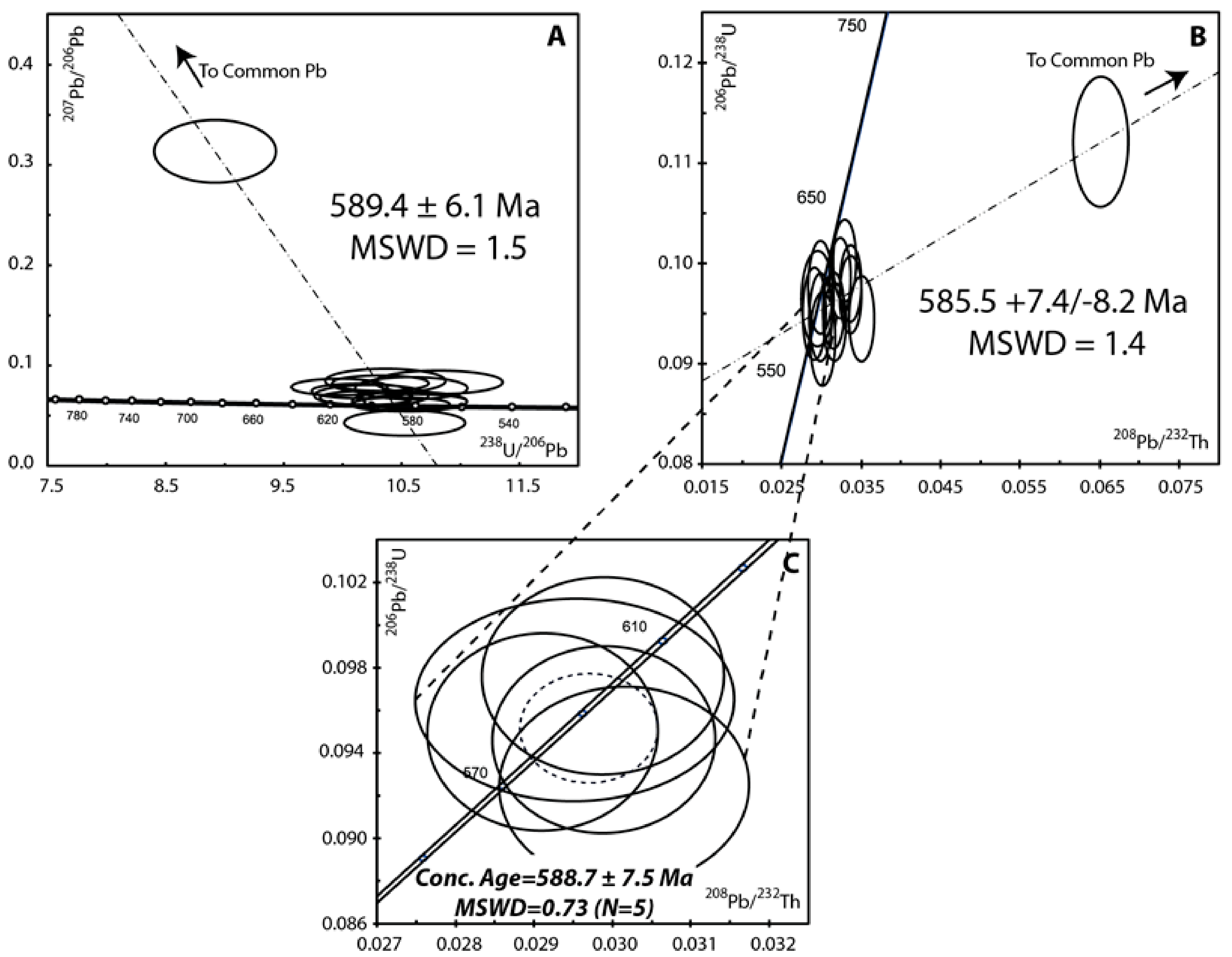
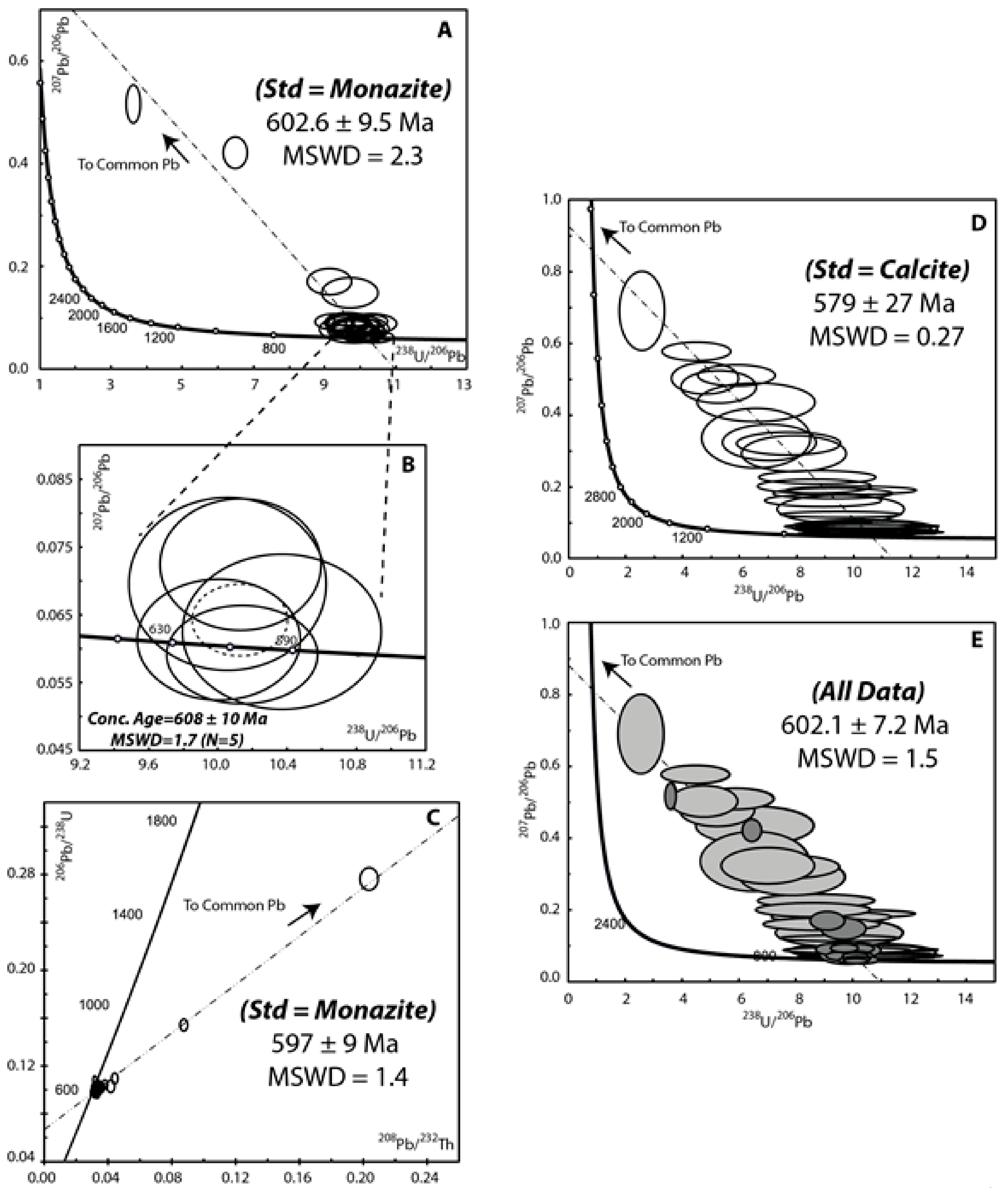
| Isotopic Ratios | Apparent Ages | |||||||||||||
|---|---|---|---|---|---|---|---|---|---|---|---|---|---|---|
| Analysis_# | Pb ppm | U ppm | Th ppm | Th/U | 238U/206Pb | Err% | 207Pb/206Pb | Err% | 208Pb/232Th | Err% | 206Pb/238U | Err | 208Pb/232Th | Err |
| S060617a-01 | 2.5 | 19 | 39 | 2.1 | 10,529 | 2.0 | 0.0428 | 12.2 | 0.0291 | 2.1 | 585 | 11 | 580 | 12 |
| S060617a-06 | 3.3 | 16 | 25 | 1.6 | 8921 | 2.4 | 0.3133 | 4.1 | 0.0651 | 2.2 | 685 | 15 | 1275 | 27 |
| S060617b-01 | 3.5 | 27 | 48 | 1.8 | 10,149 | 1.7 | 0.0746 | 4.1 | 0.0324 | 1.7 | 606 | 10 | 644 | 11 |
| S060617b-02 | 3.5 | 28 | 43 | 1.5 | 10,205 | 1.6 | 0.0677 | 4.2 | 0.0337 | 1.6 | 603 | 9 | 669 | 11 |
| S060617b-05 | 3.4 | 26 | 44 | 1.7 | 10.322 | 1.6 | 0.0824 | 3.8 | 0.0337 | 1.7 | 596 | 9 | 669 | 11 |
| S060617b-11 | 3.4 | 26 | 42 | 1.6 | 9974 | 1.7 | 0.0785 | 4.3 | 0.0329 | 1.8 | 616 | 10 | 655 | 12 |
| S060617b-14 | 2.8 | 22 | 40 | 1.8 | 10,245 | 1.9 | 0.0701 | 6.2 | 0.0299 | 2.1 | 600 | 11 | 595 | 12 |
| S060617b-18 | 2.9 | 22 | 45 | 2.1 | 10,569 | 1.9 | 0.0642 | 6.2 | 0.0299 | 1.9 | 583 | 11 | 595 | 11 |
| S060617b-19 | 2.0 | 14 | 26 | 1.8 | 10,584 | 1.8 | 0.0773 | 5.8 | 0.0351 | 1.9 | 582 | 10 | 697 | 13 |
| S060617b-20 | 2.1 | 16 | 31 | 1.9 | 10,817 | 2.1 | 0.0833 | 5.7 | 0.0302 | 2.2 | 570 | 11 | 600 | 13 |
| S060617c-04 | 3.1 | 27 | 36 | 1.3 | 10,621 | 1.7 | 0.0640 | 4.7 | 0.0317 | 1.9 | 580 | 9 | 630 | 12 |
| S060617c-14 | 3.5 | 30 | 43 | 1.4 | 10,493 | 1.6 | 0.0613 | 4.5 | 0.0315 | 1.7 | 587 | 9 | 627 | 11 |
| S060617c-15 | 1.8 | 17 | 17 | 1.0 | 10,365 | 2.0 | 0.0847 | 5.8 | 0.0295 | 2.8 | 594 | 11 | 588 | 16 |
| S060617c-18 | 1.9 | 14 | 27 | 2.0 | 10,139 | 2.3 | 0.0861 | 6.9 | 0.0340 | 2.3 | 606 | 13 | 675 | 15 |
| Isotopic Ratios | Apparent Ages | |||||||||||||
|---|---|---|---|---|---|---|---|---|---|---|---|---|---|---|
| Analysis_# | Pb ppm | U ppm | Th ppm | Th/U | 238U/206Pb | Err% | 207Pb/206Pb | Err% | 208Pb/232Th | Err% | 206Pb/238U | Err | 208Pb/232Th | Err |
| S060617b-05 | 2.5 | 20 | 29 | 1.5 | 10,131 | 1.9 | 0.0724 | 5.5 | 0.0338 | 2.1 | 607 | 11 | 673 | 14 |
| S060617b-10 | 9.6 | 29 | 59 | 2.0 | 6489 | 2.1 | 0.4215 | 3.0 | 0.0875 | 1.8 | 924 | 18 | 1696 | 30 |
| S060617b-11 | 9.3 | 14 | 26 | 1.9 | 3622 | 2.3 | 0.5165 | 2.9 | 0.2037 | 1.8 | 1572 | 31 | 3747 | 63 |
| S060617b-12 | 2.5 | 17 | 38 | 2.3 | 10,257 | 2.1 | 0.0934 | 5.4 | 0.0330 | 2.0 | 600 | 12 | 657 | 13 |
| S060617b-19 | 3.3 | 30 | 31 | 1.0 | 10,190 | 1.8 | 0.0647 | 4.9 | 0.0330 | 2.2 | 604 | 10 | 657 | 15 |
| S060617b-23 | 2.1 | 20 | 19 | 0.9 | 10,005 | 1.9 | 0.0613 | 5.9 | 0.0322 | 2.6 | 614 | 11 | 641 | 17 |
| S060617b-24 | 2.7 | 25 | 24 | 1.0 | 10,140 | 1.8 | 0.0591 | 5.0 | 0.0343 | 2.2 | 606 | 10 | 682 | 15 |
| S160617b-02 | 1.9 | 16 | 22 | 1.4 | 10,055 | 2.3 | 0.0695 | 7.5 | 0.0347 | 2.7 | 611 | 13 | 680 | 36 |
| S160617b-03 | 2.0 | 15 | 19 | 1.3 | 9713 | 3.3 | 0.1485 | 8.1 | 0.0418 | 3.9 | 632 | 20 | 1151 | 53 |
| S160617b-05 | 1.2 | 9 | 15 | 1.7 | 9651 | 2.7 | 0.0920 | 8.0 | 0.0328 | 3.1 | 636 | 16 | 852 | 45 |
| S160617b-06 | 2.0 | 13 | 19 | 1.5 | 9135 | 2.8 | 0.1703 | 6.1 | 0.0442 | 3.0 | 670 | 18 | 1292 | 42 |
| S160617b-07 | 1.5 | 13 | 13 | 1.0 | 9570 | 2.4 | 0.0891 | 7.2 | 0.0381 | 3.2 | 641 | 15 | 838 | 40 |
| S160617b-08 | 1.3 | 11 | 16 | 1.4 | 9972 | 2.8 | 0.0804 | 9.2 | 0.0322 | 3.5 | 616 | 17 | 759 | 48 |
| S160617b-11 | 1.3 | 11 | 13 | 1.2 | 10,312 | 2.8 | 0.0885 | 9.0 | 0.0331 | 3.8 | 597 | 16 | 793 | 48 |
| S160617b-13 | 1.4 | 11 | 18 | 1.7 | 9831 | 4.1 | 0.0778 | 14.2 | 0.0339 | 4.6 | 625 | 24 | 749 | 73 |
| S160617b-14 | 1.9 | 15 | 21 | 1.4 | 9609 | 2.2 | 0.0735 | 6.8 | 0.0331 | 2.6 | 638 | 13 | 731 | 35 |
| S160617b-15 | 2.2 | 19 | 25 | 1.3 | 9848 | 2.9 | 0.0822 | 9.1 | 0.0318 | 3.6 | 623 | 17 | 778 | 48 |
| S160617b-16 | 2.5 | 20 | 33 | 1.6 | 10,204 | 2.1 | 0.0744 | 6.3 | 0.0301 | 2.3 | 603 | 12 | 706 | 32 |
| S160617b-17 | 2.2 | 18 | 22 | 1.2 | 9829 | 3.0 | 0.0886 | 9.0 | 0.0337 | 3.9 | 625 | 18 | 820 | 49 |
| S160617b-18 | 2.6 | 21 | 33 | 1.6 | 9816 | 2.2 | 0.0815 | 6.3 | 0.0309 | 2.5 | 625 | 13 | 775 | 33 |
| S160617b-19 | 2.1 | 14 | 33 | 2.4 | 9284 | 2.4 | 0.0922 | 6.9 | 0.0317 | 2.4 | 660 | 15 | 876 | 39 |
| S160617b-20 | 1.7 | 13 | 20 | 1.6 | 9809 | 2.4 | 0.0832 | 7.1 | 0.0366 | 2.5 | 626 | 14 | 786 | 38 |
| S160617b-21 | 2.9 | 21 | 36 | 1.7 | 9745 | 2.0 | 0.0947 | 5.2 | 0.0348 | 2.1 | 630 | 12 | 863 | 29 |
| S160617b-22 | 3.1 | 22 | 38 | 1.8 | 9746 | 2.6 | 0.0788 | 8.1 | 0.0354 | 2.8 | 630 | 16 | 760 | 42 |
| S160617b-23 | 2.7 | 20 | 38 | 1.9 | 10,369 | 2.3 | 0.0625 | 7.5 | 0.0317 | 2.3 | 594 | 13 | 614 | 34 |
| S160617b-24 | 1.5 | 12 | 13 | 1.1 | 9671 | 2.6 | 0.0880 | 7.7 | 0.0331 | 3.5 | 634 | 15 | 826 | 42 |
| Analysis # | 207Pb/206Pb | Err% | 238U/206Pb | Err% |
|---|---|---|---|---|
| S160617a-01.d | 0.510 | 2.4 | 5.89 | 9.4 |
| S160617a-02.d | 0.435 | 5.1 | 6.58 | 12.8 |
| S160617a-03.d | 0.323 | 6.3 | 7.04 | 9.5 |
| S160617a-04.d | 0.502 | 3.6 | 4.78 | 10.0 |
| S160617a-05.d | 0.690 | 6.5 | 2.57 | 12.6 |
| S160617a-06.d | 0.122 | 2.7 | 9.55 | 9.1 |
| S160617a-08.d | 0.161 | 4.3 | 8.94 | 9.4 |
| S160617a-09.d | 0.089 | 3.7 | 9.82 | 9.3 |
| S160617a-11.d | 0.201 | 4.0 | 8.64 | 9.5 |
| S160617a-12.d | 0.137 | 11.7 | 9.55 | 9.6 |
| S160617a-13.d | 0.190 | 2.5 | 9.92 | 9.4 |
| S160617a-14.d | 0.478 | 3.9 | 5.26 | 10.3 |
| S160617a-15.d | 0.292 | 7.0 | 7.91 | 9.5 |
| S160617a-16.d | 0.077 | 1.0 | 10.52 | 9.5 |
| S160617a-17.d | 0.083 | 10.8 | 10.51 | 9.5 |
| S160617a-18.d | 0.090 | 1.9 | 10.64 | 9.0 |
| S160617a-19.d | 0.226 | 3.3 | 8.73 | 9.6 |
| S160617a-20.d | 0.072 | 2.3 | 10.75 | 9.1 |
| S160617a-21.d | 0.577 | 1.8 | 4.48 | 11.0 |
| S160617a-22.d | 0.335 | 10.1 | 6.58 | 11.8 |
| S160617a-23.d | 0.181 | 3.3 | 9.28 | 9.3 |
| S160617a-24.d | 0.087 | 9.8 | 10.29 | 9.8 |
| S160617a-25.d | 0.093 | 4.8 | 10.18 | 9.2 |
| S160617a-26.d | 0.080 | 0.8 | 10.38 | 9.3 |
| S160617a-27.d | 0.069 | 0.7 | 10.47 | 9.4 |
| S160617a-28.d | 0.320 | 4.1 | 7.72 | 9.7 |
© 2018 by the authors. Licensee MDPI, Basel, Switzerland. This article is an open access article distributed under the terms and conditions of the Creative Commons Attribution (CC BY) license (http://creativecommons.org/licenses/by/4.0/).
Share and Cite
Ntiharirizwa, S.; Boulvais, P.; Poujol, M.; Branquet, Y.; Morelli, C.; Ntungwanayo, J.; Midende, G. Geology and U-Th-Pb Dating of the Gakara REE Deposit, Burundi. Minerals 2018, 8, 394. https://doi.org/10.3390/min8090394
Ntiharirizwa S, Boulvais P, Poujol M, Branquet Y, Morelli C, Ntungwanayo J, Midende G. Geology and U-Th-Pb Dating of the Gakara REE Deposit, Burundi. Minerals. 2018; 8(9):394. https://doi.org/10.3390/min8090394
Chicago/Turabian StyleNtiharirizwa, Seconde, Philippe Boulvais, Marc Poujol, Yannick Branquet, Cesare Morelli, Joël Ntungwanayo, and Gilbert Midende. 2018. "Geology and U-Th-Pb Dating of the Gakara REE Deposit, Burundi" Minerals 8, no. 9: 394. https://doi.org/10.3390/min8090394





